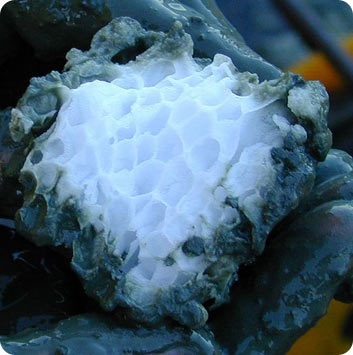The oceans can be either friend or foe. They provide food and recreation, regulate Earth’s temperature, and improve life in many other ways. But they also bring killer storms and tsunamis.
And one type of formation found on the ocean floor could be friend and foe at the same time -- a type of ice known as methane clathrate.
 Structure of a gas hydrate (methane clathrate) block embedded in the sediment of hydrate ridge, off Oregon, USA. Credit: Wikipedia
Structure of a gas hydrate (methane clathrate) block embedded in the sediment of hydrate ridge, off Oregon, USA. Credit: WikipediaAt the right temperature and pressure, water freezes around methane molecules that bubble up from layers of rock and sediment, forming ice. And there’s a lot of it: estimates range up to 10 million million tons. Since methane is a hydrocarbon -- a chemical cousin of natural gas -- it could potentially provide more energy than all the known gas and oil deposits on the planet.
Getting it to the surface is tricky, though, because as the temperature rises and the pressure decreases, the ice melts, releasing the methane into the ocean. So far, no one has developed a solution.
What no one wants is to add free methane to the water, because it could quickly make its way into the atmosphere and give a drastic boost to global warming.
There’s evidence that several ice ages ended when vast amounts of methane were released into the air. And there’s even evidence that a massive release of methane triggered a global extinction of marine life more than 600 million years ago. Today, climate scientists are concerned that warmer oceans could cause the clathrates to melt, releasing vast amounts of methane -- turning a potential friend into a deadly foe.

